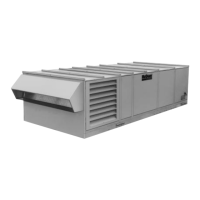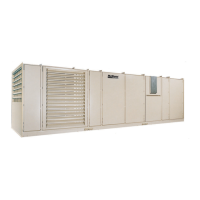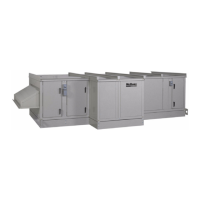McQuay IM 987 85
Unit Options
Differential Enthalpy Control (OAE/RAE)
An optional electric differential enthalpy control arrangement
(OAE/RAE) is available on units with MicroTech III control.
In this configuration a solid-state humidity and temperature
sensing device is located in both the return (RAE) and outside
intake (OAE) airstreams. This OAE device has the same A
through D scale as the device described above. However, with
the OAE/RAE arrangement the switch on, OAE must be set all
the way past the D setting. With this done, the MicroTech III
controller adjusts the return and outside air dampers to use the
airstream with the lowest enthalpy.
Ground Fault Protection
The ground fault protection is designed to protect motors from
destructive arcing ground faults. The system consists of a
ground fault relay and a ground fault current sensor. The
ground fault relay employs solid state circuits that will
instantly trip and open a set of relay contacts in the 115-volt
control circuit to shut the unit down whenever a ground fault
condition exists. The ground fault relay is self powered. The
ground fault sensor is a current transformer type of device
located on the load side of the power block through which the
power wires of all phases are run.
Phase Voltage Monitor
The phase voltage monitor (see page 113) protects against high
voltage, phase imbalance, and phase loss (single phasing)
when any one of three line voltages drops to 74% or less of
setting. This device also protects against phase reversal when
improper phase sequence is applied to equipment, and low
voltage (brownout) when all three line voltages drop to 90% or
less of setting. An indicator run light is ON when all phase
voltages are within specified limits. The phase voltage monitor
is located on the load side of the power block with a set of
contacts wired to the 115-volt control circuit to shut the unit
down whenever the phase voltages are outside the specified
limits.
External Time Clock
You can use an external time clock as an alternative to (or in
addition to) the MicroTech III controller’s internal scheduling
function. The external timing mechanism is set up to open and
close the circuit between field terminals 101 and 102. When
the circuit is open, power is not supplied to binary input
MCB-BI1. This is the normal condition where the controller
follows the programmable internal schedule. When the circuit
is closed, power is fed to BI1. The MicroTech III controller
responds by placing the unit in the occupied mode, overriding
any set internal schedule.
For more information, see the “Digital Inputs” section of IM
919, “MicroTech III Applied Rooftop Unit Controller.”
Smoke and Fire Protection
McQuay optionally offers factory installed outdoor air, return
air, and exhaust air dampers as well as smoke detectors in the
supply and return air openings, complete with wiring and
control. These components often are used in the building’s
smoke, fume, and fire protection systems. However, due to the
wide variation in building design and ambient operating
conditions into which our units are applied, we do not
represent or warrant that our products will be fit and sufficient
for smoke, fume, and fire control purposes. The owner and a
fully qualified building designer are responsible for meeting
all local and NFPA building code requirements with respect to
smoke, fume, and fire control.
Smoke Detectors
Field installed smoke detectors in the return air ductwork or
the supply air ductwork can be coordinated with the units
operation through the unit controller's binary input, D14. This
input in wired to TB2 and the supply air smoke detector can be
wired between terminals 103 and 104 and the return air smoke
detector can be wired between terminals 104 and 105. The T2
transformer supplies 24 V (ac) across each of these terminals
and a dry set of contacts can be wired to these terminals
respectively. This and additional wiring information can be
seen on the input wiring schematics at line number 220.
Figure 95: Smoke Detector Schematic
WARNING
Improper smoke, fire, or fume air handling can result in
severe personal injury or death.

